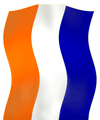

Daily Log, September 7, 2003
We came to anchor under a brilliant moon with a clear sky last night. With the cool night air and pleasant conditions, we decided to go as far as the Palisades, even though it meant coming to anchor at about 10PM. The first order of business was anchor watch - all the crew needed to understand how to stand watch at night. Two student crew members stand watch for an hour, and then are relieved by two others, and so on until morning. Everyone got a great view of Mars, which is very bright now, and constellations like Scorpio. We could also see beautiful lights on the George Washington Bridge, and on buildings in New York City.After traveling from the Palisades past New York City, and sailing in Raritan Bay, and completing our training, we came to anchor in Graves End Bay, just below the Verrazano Narrows. Each night when we anchor we must identify landmarks to help with anchor watch.
At anchor we discussed our special study projects. We will all do many different jobs, some with the ship and some with education. Each of us will also work on a special project, and at the end of the week we will make a presentation to the entire crew about our research. Some are working on the weather, some on environmental measurements, some on navigation; everyone will make measurements and take data and make graphs.
|
This is the view south this morning, showing the George Washington Bridge. Look closely and you can see the Empire State Building. |
|
| Weighing anchor is a complex task, and is done just the same way as in Hudson's time. We have one team on the capstan, one team below deck with the anchor rope, and one team on the foredeck to control the anchor when it comes up. |
The teams must work together very carefully, even though they cannot see each other, or even speak directly. We need to place crew in between to communicate. The communicator must be very careful not to confuse what is said, because a mistake can cause a serious problem. |
| Steph and Alex are part of the below deck crew. Behind them are the bits where the anchor rope is tied - this is in the forward part of the ship. Just to the side is the anchor chain. The chain and the rope together weigh hundreds of pounds It took about twenty minutes to weigh the anchor (weight means raise). |
The anchor is now secure, and we can remove the capstan bars from the capstan and stow them in special rack. Every job on the ship has a very special way of being done, and a reason for being done that way. |
| Ms Farrell is in the helm hutch steering the ship. The big ball of rope in front of her is the bell rope. The person on the helm cannot see in front of the ship. The lookout must report other boats and objects to the Captain, who then gives directions to the person steering. |
Now it's Leanne's turn. It is difficult to hear in the helm hutch, so the Captain and the Helmsperson must make sure to confirm each communication to ensure that it is done correctly. |
We see all kinds of boats near Manhattan. Many recreational boats come too close; they want to get a good look at us, but seem to forget that getting so close can be a problem. |
The Staten Island Ferries run all the time. They are interesting to see. |
| We receive training in every job. Going in the rigging is popular, but also serious. We need to wear safety harnesses, and double check everything we do. Certain jobs, like furling the sails, require going aloft. Before we can go aloft, we must go through the training.
|
Here Coretta is in the top (what some people incorrectly call a crow's nest). She is about 65 feet above the deck, which is why it is so important to go through the training and do this well. The top is where the topsails are handled. |
| This is below decks, where we sleep and work. You can see the bottom of the main mast, with the anchor watch schedule on it. Behind the main mast you can see the decks where we spread our sleeping bags at night, and where we have our gear during the day. Mr. Linehan's legs can be seen near the lower part of the capstan, where he was working with the anchor weighing team. |
We sailed for several hours in Raritan Bay, below the Narrows. This is the area where Henry Hudson first anchored in 1609 when he came into New York Harbor. We can see Sandy Hook, Staten Island, Coney Island, the Narrows, and New Jersey. We set our mainsail and foresail, and our topsails. We also washed the decks with seawater. We were so busy we did not get photographs of the sails set, but will get them the next time. |
| Empire State Building |
In the background you can see the Statue of Libery. |